Muscle atrophy in dogs sneaks up quietly, yet the changes in their body feel loud. Muscles shrink, steps slow down, and energy dips. Still, this isn't the end of their playful spirit.
With attentive care and the right support, pups can regain strength and keep enjoying life. Your canine companion's muscles may fade, but your devotion fuels their bounce back.
What Is Muscle Atrophy in Dogs?

Muscle atrophy in dogs means their muscles shrink or lose strength. This often affects the hind legs, making walking, climbing, or jumping harder. The changes can develop slowly, so early clues sometimes go unnoticed.
Dogs with muscle wastage show less tone and energy. They may tire quickly or struggle with daily activities. Spotting these shifts early helps prevent severe muscle atrophy and supports long-term health.
Understanding Muscle Loss in Dogs
Muscle loss in dogs happens when muscle tissue weakens or fades. This may follow an injury, a sedentary lifestyle, or natural aging. The process can occur slowly, so the first signs often slip past unnoticed. Over time, the affected muscles become smaller, and movement gets harder.
Dogs with muscle weakness and shrinkage may appear thinner around the hips or back legs. Some pups lose energy or struggle with regular exercise. Others may show stiffness or soreness. Catching these changes helps owners take action early.
Difference Between Normal Aging and Muscle Atrophy
Aging causes gradual changes in a dog's body, including slower movement and reduced stamina. Muscles may look softer, but strength usually remains steady enough to support a fairly active life. These shifts are part of growing older and happen at a gentle pace.
Muscle atrophy, however, involves sharper loss of muscle mass and tone. Affected areas shrink faster, and dogs may show weakness, soreness, or trouble standing. Unlike normal aging, muscle wasting signals an underlying condition that calls for closer attention.
Common Causes of Muscle Atrophy in Dogs
Muscle atrophy in dogs doesn't happen for just one reason. Several factors can cause the shrinking, each affecting the body in a different way. They include:
- Natural Aging Process. Muscles weaken as dogs grow older.
- Lack of Physical Activity. Reduced movement leads to muscle wasting.
- Injury or Trauma. Hurt legs or back limit movement, causing loss of muscle tone.
- Neurological Conditions. Spinal cord issues or nerve damage affect muscle use.
- Joint Problems and Arthritis. Soreness and stiffness limit mobility.
- Poor Nutrition or Underlying Illness. Without proper nutrition, muscle loss can occur faster.
Signs and Symptoms of Muscle Atrophy in Dogs

Muscle atrophy in dogs often shows clear changes in their body and behavior. Paying close attention to your pup's movement and energy can reveal early clues, such as:
- Visible Muscle Wasting. Thinner legs, hips, or shoulders.
- Weakness and Stiffness. Trouble rising or walking smoothly.
- Difficulty Walking or Climbing. Struggles with stairs or jumping.
- Weight Loss and Reduced Energy. Noticeable drop in body mass and energy levels. Find your dog's average body weights here.
- Postural Changes. Hunched back or uneven stance.
Dogs Prone to Muscle Atrophy
Some dogs face a higher risk of muscle atrophy than others. Breed, lifestyle, and age can come into play. Be mindful if your pup belongs to any of these groups:
- Large Breed Dogs. Heavier frames put extra stress on joints and muscles.
- Working Dogs and Athletic Breeds. Injuries or overuse may trigger muscle wastage.
- Senior Dogs of All Breeds. Aging naturally reduces muscle mass and strength.
Diagnosing Muscle Atrophy in Dogs
Diagnosing muscle atrophy in dogs begins with a physical examination. A vet checks the dog's muscles, posture, and movement to spot weak or thinning areas. This step often reveals the first signs of loss.
Imaging tests such as X-rays, MRI, or a CT scan give a closer look at bones and soft tissue. Blood tests and other lab work can uncover underlying conditions, if any. Together, these tools help find the cause and guide treatment options.
How To Support Dogs With Muscle Atrophy
Dogs experiencing muscle atrophy benefit from steady care and targeted support. The right steps often depend on the underlying cause. Here are some things that can work:
- Regular Low-Impact Exercise
- Physical Therapy and Hydrotherapy
- Balanced Nutrition and Supplements
- Pain Management Strategies
- Supportive Home Adjustments
Regular Low-Impact Exercise
Low-impact activity helps maintain muscles without straining the joints. Gentle walks on soft ground, short play sessions, or slow-paced movements keep your pooch active while protecting tender areas. Swimming is another great choice, as it works many areas without pressure on the legs. Even a few minutes of daily activity can slow down muscle wasting and help your furry buddy remain active.
Physical Therapy and Hydrotherapy
Physical therapy strengthens a dog's muscles through guided stretches and specific exercises. Trained professionals design routines that target the affected muscles and improve mobility. These sessions often help pups regain balance and reduce stiffness.
Hydrotherapy adds water resistance while easing pressure on the joints. Walking on an underwater treadmill or swimming in warm water builds strong muscles without pain. Many pets find this soothing and enjoyable, making it easier to stay active.
Balanced Nutrition and Supplements
Healthy meals with quality protein help rebuild muscle tissue and maintain muscle tone. Without the right nutrients, dogs may lose mass more quickly.
Wellness products like amino acids or multivitamins can give an extra boost. These natural additions to a daily routine may help maintain mass and energy. A balanced diet paired with supportive products keeps dogs healthier and more active.
Pain Management Strategies
Dogs with muscle atrophy often deal with soreness or aches that limit movement. Managing this discomfort helps them stay mobile and more willing to move. Simple steps like soft bedding or gentle massages can provide relief at home. Veterinarians may also suggest therapeutic products or treatments to help ease irritation in the joints and muscles.
Supportive Home Adjustments
Adding rugs or mats gives better traction and prevents slips on slick floors. Ramps or steps help pets, especially geriatric dogs, reach couches, beds, or cars without straining their legs. Raised food and water bowls help reduce pressure on the neck and joints. These small changes support mobility and help pups stay confident in daily life.
HolistaPet Muscle Support Soft Chews for Dogs: Everyday Support for Stronger Steps

As muscle atrophy progresses, our canine friends may face stiffness and joint instability. HolistaPet's Muscle Support Soft Chews offer a tasty way to support muscle strength and daily activity. These heart-shaped chews blend amino acids with muscle-building ingredients to back your pup's active lifestyle.
With a peanut butter and banana flavor, dogs enjoy every bite. Made with all-natural ingredients, they help maintain muscle tone and keep pets moving with confidence. Spot more of our mobility products here: HolistaPet Mobility Collection.
Preventing Muscle Atrophy in Dogs
Preventing muscle atrophy in dogs starts with daily care and simple habits. Taking these steps early keeps muscle disorders at bay and contributes to long-term strength:
- Maintaining an Active Lifestyle
- Weight Management and Proper Diet
- Early Intervention and Routine Vet Care
Maintaining an Active Lifestyle
Active dogs keep their muscles stronger for longer. Daily walks, light play, and gentle games keep the body moving and the joints flexible. Even short sessions of activity help reduce stiffness and support toning.
Consistency matters more than intensity. Regular movement prevents muscles from shrinking and keeps energy levels higher. A steady routine of safe exercise helps pups stay mobile, alert, and ready for daily adventures.
Weight Management and Proper Diet
Extra weight puts stress on a dog's joints and muscles, making atrophy worse. Keeping your pup at a healthy size, therefore, reduces pressure on their legs and supports easier movement. Regular weigh-ins and portion control should be part of your plan.
A proper diet rich in protein and balanced nutrients fuels the muscles. The right dog food meets these daily nutritional needs while keeping energy steady. Practice good feeding habits to protect your pet's muscle mass and overall health.
Early Intervention and Routine Vet Care
Catching the first signs of muscle atrophy gives dogs a better chance at staying strong. Regular checkups let vets spot small changes before they turn serious. This quick action helps protect muscle tone and overall mobility.
Routine care may include physical exams, blood tests, or imaging. These tools reveal underlying conditions that cause muscle loss. Staying proactive with vet visits keeps your furry buddy healthier and more active over time.
When To See a Veterinarian
Some cases of muscle atrophy in dogs need quick veterinary attention. Acting fast helps address the problem before it worsens. Watch for these signs that call for a professional check:
- Sudden Muscle Loss. Quick, noticeable shrinking of muscle mass.
- Severe Weakness or Pain. Difficulty standing or visible soreness.
- Inability to Stand or Walk. Loss of mobility that appears suddenly or worsens quickly.
FAQs About Muscle Atrophy in Dogs
Understanding the basics of muscle loss in dogs helps ease worry and makes care choices easier. These answers cover common concerns and provide simple guidance.
Can muscle atrophy in dogs be reversed?
In some cases, muscle atrophy can improve with the right care. Regular exercise, physical therapy, and balanced nutrition may help rebuild strength. The success depends on the underlying cause, such as injury or aging. Early action often gives the best results.
How long does it take for muscle atrophy to develop?
Muscle atrophy can develop slowly over weeks or months, often making it hard to notice at first. Disuse atrophy occurs when a dog rests too long due to illness, injury, or crate rest. Sudden onset may appear quickly if linked to neurological issues. Watching closely for early signs helps catch problems before they worsen.
What foods or supplements help dogs with muscle loss?
High-quality dog food with protein supports muscle development and overall energy. Wellness products with amino acids or vitamins may also help maintain muscle mass. Some owners add natural additions, like HolistaPet chews for extra support. Always check with a vet before starting new products.
Are senior dogs more likely to develop muscle atrophy?
Yes, senior dogs face a higher risk of muscle atrophy. Aging naturally reduces muscle mass and slows recovery from injuries. Joint problems or reduced activity make the loss more noticeable in older pups. Regular checkups and gentle exercise help slow the process.
Can exercise alone stop muscle atrophy?
Exercise supports strong muscles, but it may not fully stop muscle atrophy on its own. The best results come from combining movement with proper diet and supportive care. Dogs with underlying conditions may also need physical therapy or other treatments. A balanced approach gives pups the most benefit.
Do joint support supplements help with muscle atrophy?
Joint support supplements can make movement easier, which encourages dogs to stay active. Less soreness allows for more exercise, helping maintain muscle mass. While they don't directly rebuild muscle, they support the body's ability to stay mobile. Many pet owners find them a useful part of care.
The Bottom Line on Muscle Atrophy in Dogs
Muscle atrophy in dogs may sound overwhelming, but steady care makes a real difference. Early signs like weakness or shrinking muscles deserve attention and support. With exercise, good food, and regular vet visits, many pups stay strong and mobile.
For added support, HolistaPet's Muscle Support Soft Chews for Dogs provide a tasty way to back muscle strength and daily activity. Simple steps like these keep your furry friend moving with confidence.

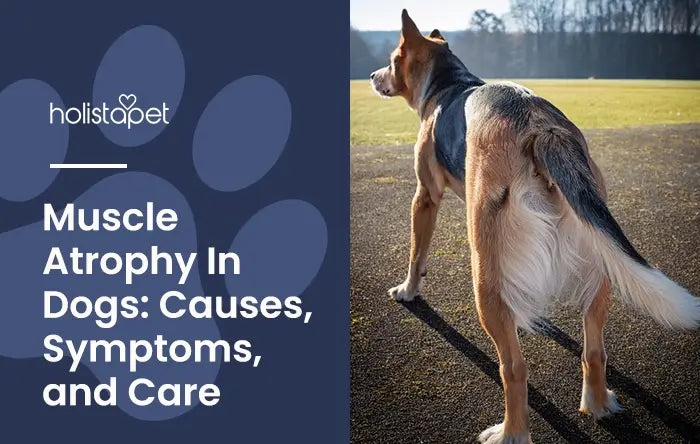
 CBD Oil for Dogs - Fast Acting
CBD Oil for Dogs - Fast Acting
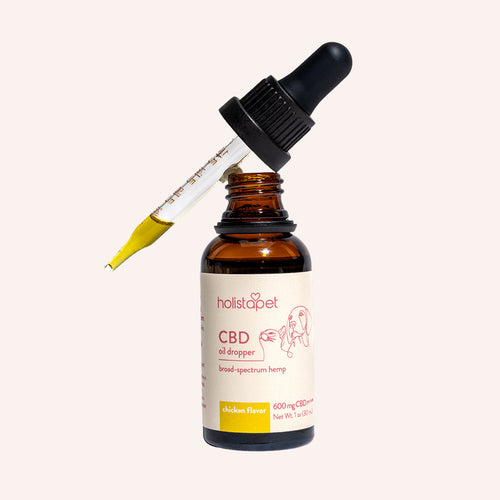 Chicken Flavored CBD Oil For Dogs - Easy Dose
Chicken Flavored CBD Oil For Dogs - Easy Dose
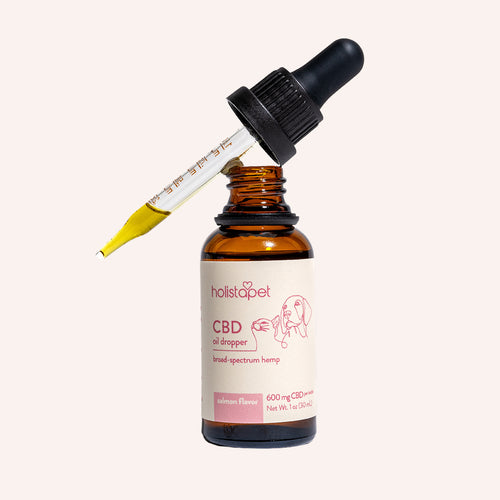 Salmon Flavored CBD Oil For Dogs - Highly Rated
Salmon Flavored CBD Oil For Dogs - Highly Rated
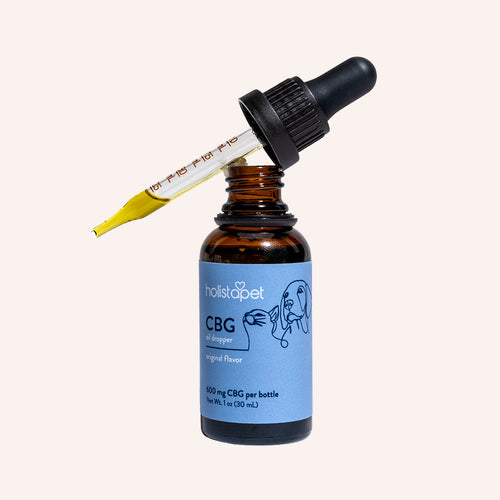 CBG Oil for Dogs and Cats - Loved by Thousands
CBG Oil for Dogs and Cats - Loved by Thousands



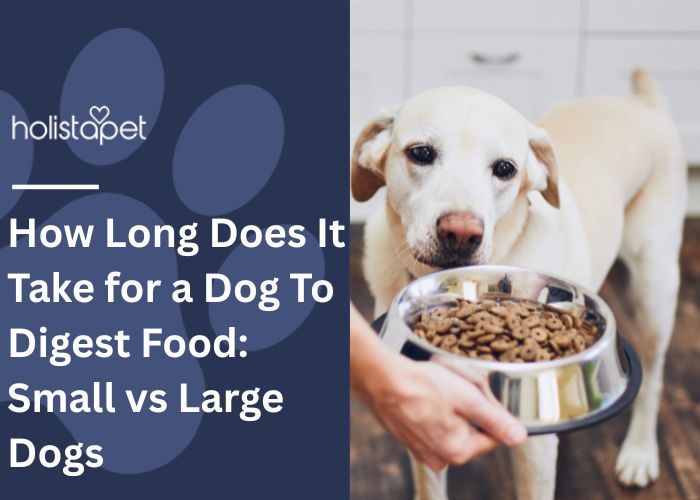

Leave a comment
All comments are moderated before being published.
This site is protected by hCaptcha and the hCaptcha Privacy Policy and Terms of Service apply.